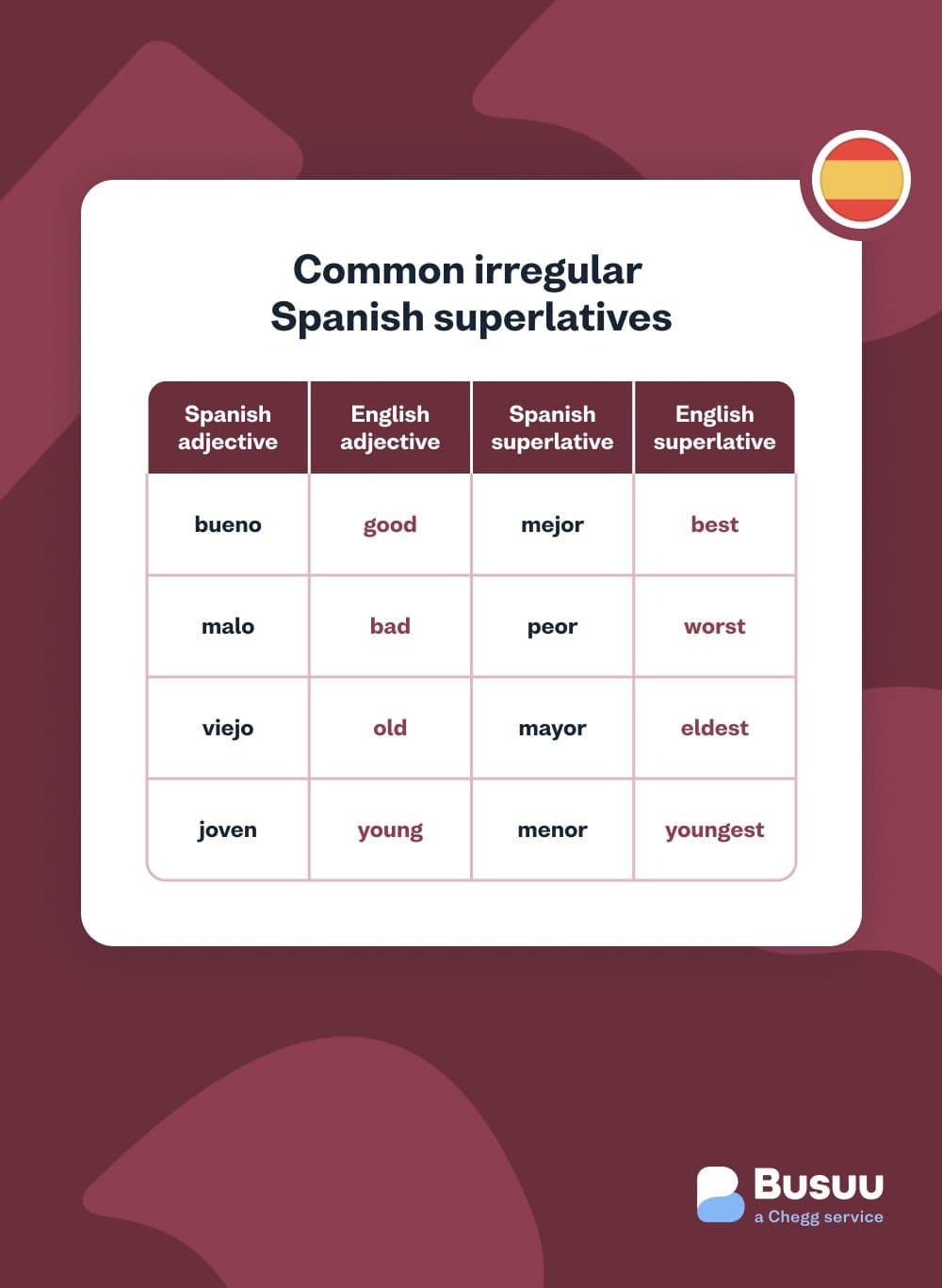I want to learn...
Imagine you’re in a new city and you’re on the hunt for an incredible Spanish restaurant. No, not just incredible, you want the best Spanish restaurant in town! And so you decide to ask some locals, but how can you express that what you are looking for shouldn’t just be good, but the best?
That’s when Spanish superlatives come into play.
¡Vamos a ello!
Let’s begin!
Spanish superlatives
Superlatives in Spanish help us specify whether something is at the top or bottom of its class; they indicate that a person or thing has a quality or characteristic that exceeds others in its category.
Spanish superlatives can be absolute or relative. The relative superlative is used when describing the noun in the context of a larger group whereas the absolute superlative doesn’t describe the noun in the context of a larger group. Let’s take a look here and see some examples of how we can use them.
Regular relative superlatives in Spanish: el / la / los / las + noun + más/menos + adjective
One way to form the relative superlatives in Spanish is with the definite articles el / la / los / las (the) combined with más (more) or menos (less), followed by the adjective used to describe the noun. As always, make sure that the adjective and the noun agree in both number and gender.
In English, this would be like saying something or someone is the “nicest / best / worst / most interesting etc”.
Whether or not you include the noun is optional, but we’ll include it in our first examples so that you can see what the sentence structure looks like when it’s there.
To form a sentence using the relative superlatives in Spanish, we use the following structure:
el / la / los / las (the) + noun +más / menos (more / less) + adjective
Here are some example sentences:
El libro más interesante. (The most interesting book.)
Compré el coche menos caro. (I bought the least expensive car.)
When context allows, it’s okay to drop the noun from the sentence.
Here’s an example of using a superlative in a sentence without the noun:
La más emocionante. (the film, feminine) The most exciting one. (one=film)
Regular relative superlatives with de + noun and que + verb
Another way to form the relative superlative is using the above structure followed by de (of) + noun or que (than) + verb.
When we use de + noun, we can specify the group or category being compared to.
Here is an example:
Juan es el estudiante más inteligente de la clase. (Juan is the smartest student in the class.)
When we use que + verb, we can emphasize a comparison being made to a certain action or quality.
Here is an example:
Es la película más emocionante que he visto. (It is the most exciting movie I have seen.)
Irregular relative superlatives in Spanish
So far, we’ve looked at regular relative superlatives in Spanish, let’s take a look at irregular ones too.
These superlatives are considered irregular because the adjective changes to form the superlative. With these superlatives, we don’t usemásormenosand sometimes the adjective comes before the noun.

Common irregular Spanish superlatives
| Spanish Adjective | English Adjective | Spanish Superlative | English Superlative |
|---|---|---|---|
| bueno | good | mejor | best |
| malo | bad | peor | worst |
| viejo | old | mayor | eldest |
| joven | young | menor | youngest |
Here are some examples:
Este restaurante tiene la mejor comida de la ciudad. (This restaurant has the best food in the city.)
Mi hermana mayor se mudó a otra ciudad. (My eldest sister moved to another city.)
Absolute superlatives in Spanish: Usingísimo / a / os / as, muy, and sumamente
There are other superlative forms in Spanish known as absolute superlatives. Absolute superlatives are used to express extreme degrees of a quality without making a comparison to something else.
In English, this would sound like saying something or someone is “extremely / incredibly / very kind / interesting / fun etc”.
There are three different ways to do this. Let’s take a look!
1. Absolute superlative: Adjective + -
To form the absolute superlative this way, first, determine the gender and number of the adjective and then add the superlative ending that matches (-ísimo / a / os / as) directly to the end of the adjective. Be aware that if the adjective ends in a vowel, you will have to drop it to add the superlative ending.
alt(o) + ísimo = altísimo (extremely tall, masculine singular)
pequeñ(a) + ísima = pequeñísima (extremely small, feminine singular)
important(e) + ísimo + importantísimos (extremely important, masculine plural)
Here are some examples of sentences using the absolute superlative:
Ella es amabilísima con todos. (She is extremely kind to everyone.)
El pastel estaba deliciosísimo. (The cake was incredibly delicious.)
Mis abuelos son fortísimos. (My grandparents are extremely strong.)
Note: Here “fortísimo" changes its stem when forming the superlative from “fuerte”. There isn’t a rule for this, but you will find some adjectives that behave this way. It’s also normal and correct to use the regular form “fuertísimo” in colloquial Spanish as well.
2. Absolute superlative: muy + adjective
Another way to form absolute superlatives is by using muy (very) combined with an adjective. Again, make sure that the adjective and noun agree in number and gender.
Here are some examples:
Esos libros son muy interesantes. (Those books are very interesting.)
Esa ciudad es muy hermosa. (That city is very beautiful.)
3. Absolute superlative: sumamente + adjective
And lastly, another way to form the absolute superlative is by using sumamente (extremely/highly) combined with an adjective. As with the other absolute superlative forms, make sure that the noun and adjective agree in number and gender.
Here are some examples:
La película fue sumamente emocionante. (The movie was extremely exciting.)
Las actuaciones fueron sumamente cautivadoras. (The performances were extremely captivating.)
Spanish superlatives: Relative or absolute?
We’ve covered different ways to use superlatives in Spanish, so let’s clarify when to use them.
Context and personal preference may be a factor, but in general:
Use the relative superlative structure “el / la / los / las + noun + más / menos + adjective” when comparing within a group or making a general superlative statement.
Use the absolute superlative when emphasizing the extreme degree of a quality or attribute without making a comparison.
Another thing to consider is the region you are in. The adjective + -ísimo / a / os / asis commonly used throughout Spain, but less so in Latin American countries. ( Check out our article on the differences of Spanish used in Spain and Latin America)
In fact, some Latin American countries even usereorrecontra+ adjective (think of it like “super” + adjective) instead of the -ísimo / a / os / asendings, but we won’t dive into that here.
Spanish superlatives: Let’s wrap things up
We have covered a lot in this article, so let’s take a second to wrap everything up.
In Spanish, we use the relative superlative to demonstrate that something or someone has a quality or characteristic that surpasses others in the same category. We also use absolute superlatives to emphasize the extreme degree of a quality or characteristic of something without comparing it to something else.
To master Spanish superlatives, you’ll need to immerse yourself in a Spanish-speaking context, such as music or movies, and make sure that you continue to study with the help of articles like this one.
If you stay consistent, you’ll be speaking like a pro in no time.
¡Excelente trabajo!
Great work!
Newlanguages


